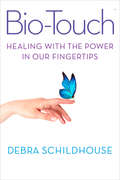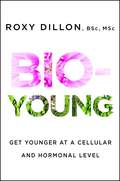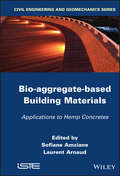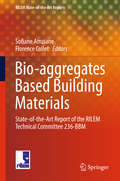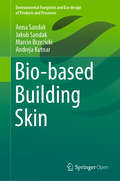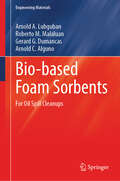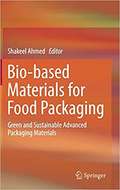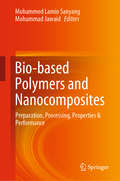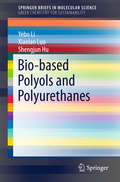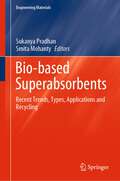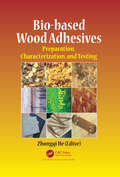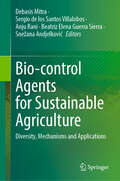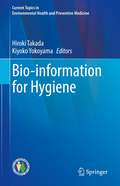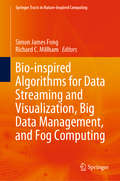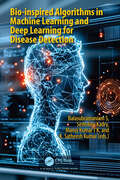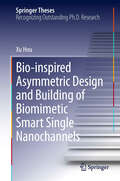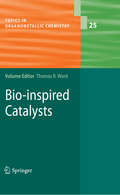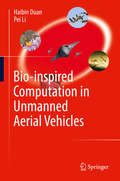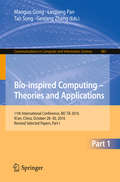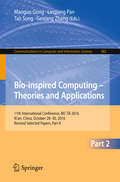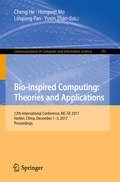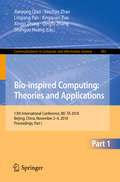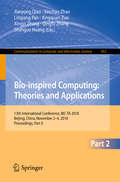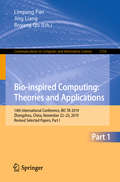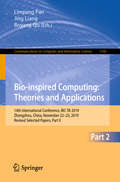- Table View
- List View
Bio-Touch: Healing with the Power In Our Fingertips
by Gary E. Schwartz Debra SchildhouseWith just two fingers from each hand, the healing process can begin. Bio-Touch: Healing with the Power in Our Fingertips is the story of the scientifically-proven, touch-based healing technique proven to alleviate pain, stress, the symptoms of disease, and depression. Debra Schildhouse, an initial skeptic, is drawn to Bio-Touch after feeling helpless to do anything for her daughter's agonizing headaches from a mysterious illness. Her search for a method to heal others' pain gradually becomes an inner journey of personal healing as she opens her mind and eventually becomes a certified instructor and practitioner of Bio-Touch. In tandem with her own story, Schildhouse recounts Bio-Touch founder Paul Bucky's journey as he follows his spiritual path to the discovery of Bio-Touch. Throughout the narrative Schildhouse relates miraculous stories of healing. Touching and often funny, Bio-Touch draws together the many invisible bonds of the universe linking us all together.
Bio-Young
by Roxy DillonA groundbreaking, easy-to-follow, all-natural anti-aging program using vitamins, natural oils, and many common foods that will help you to look and feel younger.You've always heard that "age is just a number"--now Roxy Dillon, the Youth Guru, has the science to prove it. Those wrinkles under your eyes are not simply an inevitable part of the aging process. Actually, those unpleasant surprises in the mirror are a result of the decline in your cellular and hormonal functions. Science shows us that your hormones quickly decline after age thirty, leading to a variety of changes in your body including hair loss, saggy skin, and unwanted facial hair. The good news is that all of your aging symptoms can be halted--and even reversed. In Bio-Young, renowned anti-aging expert Roxy Dillon guides you through an easy-to-follow regimen that will naturally stop and reverse the aging process. Amazingly, common plants and foods contain compounds that are now scientifically proven to stimulate cellular and hormonal function, and actually reverse aging! Using ingredients that you can find at home, you can stimulate your hormone-producing glands into youthful activity again. Discover the bio-actives--foods, herbs, supplements, edibles, and essential oils--that you should be eating, or applying externally, and learn how their key compounds (such as resveratrol in red wine, squalene in olive oil, or ferulic acid in rice bran oil) will plump your skin, reduce high blood pressure, and even fight cancer cells. From restoring thinning hair with rosemary and smoothing wrinkles with honey, to preventing grey hair with onion juice--there's a natural solution for every problem. Roxy has created a clear-cut program that will help you take control of your looks and turn back the clock. Get ready to look and feel years younger!
Bio-aggregate-based Building Materials: Applications to Hemp Concretes (Rilem State-of-the-art Reports #23)
by Laurent Arnaud Sofiane AmzianeUsing plant material as raw materials for construction is a relatively recent and original topic of research. This book presents an overview of the current knowledge on the material properties and environmental impact of construction materials made from plant particles, which are renewable, recyclable and easily available. It focuses on particles and as well on fibers issued from hemp plant, as well as discussing hemp concretes. The book begins by setting the environmental, economic and social context of agro-concretes, before discussing the nature of plant-based aggregates and binders. The formulation, implementation and mechanical behavior of such building materials are the subject of the following chapters. The focus is then put upon the hygrothermal behavior and acoustical properties of hempcrete, followed by the use of plant-based concretes in structures. The book concludes with the study of life-cycle analysis (LCA) of the environmental characteristics of a banked hempcrete wall on a wooden skeleton. Contents 1. Environmental, Economic and Social Context of Agro-Concretes, Vincent Nozahic and Sofiane Amziane. 2. Characterization of Plant-Based Aggregates. Vincent Picandet. 3. Binders, Gilles Escadeillas, Camille Magniont, Sofiane Amziane and Vincent Nozahic. 4. Formulation and Implementation, Christophe Lanos, Florence Collet, Gérard Lenain and Yves Hustache. 5. Mechanical Behavior, Laurent Arnaud, Sofiane Amziane, Vincent Nozahic and Etienne Gourlay. 6. Hygrothermal Behavior of Hempcrete, Laurent Arnaud, Driss Samri and Étienne Gourlay. 7. Acoustical Properties of Hemp Concretes, Philippe Glé, Emmanuel Gourdon and Laurent Arnaud. 8. Plant-Based Concretes in Structures: Structural Aspect – Addition of a Wooden Support to Absorb the Strain, Philippe Munoz and Didier Pipet. 9. Examination of the Environmental Characteristics of a Banked Hempcrete Wall on a Wooden Skeleton, by Lifecycle Analysis: Feedback on the LCA Experiment from 2005, Marie-Pierre Boutin and Cyril Flamin. About the Authors Sofiane Amziane is Professor and head of the Civil Engineering department at POLYTECH Clermont-Ferrand in France. He is also in charge of the research program dealing with bio-based building materials at Blaise Pascal University (Institut Pascal, Clermont Ferrand, France). He is the secretary of the RILEM Technical Committee 236-BBM dealing with bio-based building materials and the author or co-author of over one hundred papers in scientific journals such as Cement and Concrete Research, Composite Structures or Construction Building Materials as well as international conferences. Laurent Arnaud is a Bridges, Waters and Forestry Engineer (Ingénieur des Ponts, Eaux et Forêts) and researcher at Joseph Fourier University in Grenoble, France. He is also Professor at ENTPE (Ecole Nationale des Travaux Publics de l’Etat). Trained in the field of mechanical engineering, his research has been directed toward the characterization and development of new materials for civil engineering and construction. He is head of the international committee at RILEM – BBM, as well as the author of more than one hundred publications, and holder of an international invention patent.
Bio-aggregates Based Building Materials: State-of-the-Art Report of the RILEM Technical Committee 236-BBM (RILEM State-of-the-Art Reports #23)
by Sofiane Amziane Florence ColletUsing plant material as raw materials for construction is a relatively recent and original topic of research. This book presents an overview of the current knowledge on the material properties and environmental impact of construction materials made from plant particles, which are renewable, recyclable and easily available. It focuses on particles and as well on fibers issued from hemp plant, as well as discussing hemp concretes. The book begins by setting the environmental, economic and social context of agro-concretes, before discussing the nature of plant-based aggregates and binders. The formulation, implementation and mechanical behavior of such building materials are the subject of the following chapters. The focus is then put upon the hygrothermal behavior and acoustical properties of hempcrete, followed by the use of plant-based concretes in structures. The book concludes with the study of life-cycle analysis (LCA) of the environmental characteristics of a banked hempcrete wall on a wooden skeleton. Contents 1. Environmental, Economic and Social Context of Agro-Concretes, Vincent Nozahic and Sofiane Amziane. 2. Characterization of Plant-Based Aggregates. Vincent Picandet. 3. Binders, Gilles Escadeillas, Camille Magniont, Sofiane Amziane and Vincent Nozahic. 4. Formulation and Implementation, Christophe Lanos, Florence Collet, G#65533;rard Lenain and Yves Hustache. 5. Mechanical Behavior, Laurent Arnaud, Sofiane Amziane, Vincent Nozahic and Etienne Gourlay. 6. Hygrothermal Behavior of Hempcrete, Laurent Arnaud, Driss Samri and #65533;tienne Gourlay. 7. Acoustical Properties of Hemp Concretes, Philippe Gl#65533;, Emmanuel Gourdon and Laurent Arnaud. 8. Plant-Based Concretes in Structures: Structural Aspect - Addition of a Wooden Support to Absorb the Strain, Philippe Munoz and Didier Pipet. 9. Examination of the Environmental Characteristics of a Banked Hempcrete Wall on a Wooden Skeleton, by Lifecycle Analysis: Feedback on the LCA Experiment from 2005, Marie-Pierre Boutin and Cyril Flamin. About the Authors Sofiane Amziane is Professor and head of the Civil Engineering department at POLYTECH Clermont-Ferrand in France. He is also in charge of the research program dealing with bio-based building materials at Blaise Pascal University (Institut Pascal, Clermont Ferrand, France). He is the secretary of the RILEM Technical Committee 236-BBM dealing with bio-based building materials and the author or co-author of over one hundred papers in scientific journals such as Cement and Concrete Research, Composite Structures or Construction Building Materials as well as international conferences. Laurent Arnaud is a Bridges, Waters and Forestry Engineer (Ing#65533;nieur des Ponts, Eaux et For#65533;ts) and researcher at Joseph Fourier University in Grenoble, France. He is also Professor at ENTPE (Ecole Nationale des Travaux Publics de l'Etat). Trained in the field of mechanical engineering, his research has been directed toward the characterization and development of new materials for civil engineering and construction. He is head of the international committee at RILEM - BBM, as well as the author of more than one hundred publications, and holder of an international invention patent.
Bio-based Building Skin (Environmental Footprints and Eco-design of Products and Processes)
by Andreja Kutnar Anna Sandak Jakub Sandak Marcin BrzezickiThis book provides a compendium of material properties, demonstrates several successful examples of bio-based materials’ application in building facades, and offers ideas for new designs and novel solutions. It features a state-of-the-art review, addresses the latest trends in material selection, assembling systems, and innovative functions of facades in detail. Selected case studies on buildings from diverse locations are subsequently presented to demonstrate the successful implementation of various biomaterial solutions, which defines unique architectural styles and building functions. The structures, morphologies and aesthetic impressions related to bio-based building facades are discussed from the perspective of art and innovation; essential factors influencing the performance of materials with respect to functionality and safety are also presented. Special emphasis is placed on assessing the performance of a given facade throughout the service life of a building, and after its end. The book not only provides an excellent source of technical and scientific information, but also contributes to public awareness by demonstrating the benefits to be gained from the proper use of bio-based materials in facades. As such, it will appeal to a broad audience including architects, engineers, designers and building contractors.
Bio-based Foam Sorbents: For Oil Spill Cleanups (Engineering Materials)
by Arnold A. Lubguban Roberto M. Malaluan Gerard G. Dumancas Arnold C. AlgunoThis book highlights the advantages of using sorbents in oil spill cleanup while dealing with the challenges of limited capacity and disposal. Bio-based foam sorbents are new but promising sorbents to oil spill cleanup. They are environmentally friendly materials derived from renewable resources such as vegetable oil and biomass, designed to absorb or adsorb oil and other pollutants from water, coastal areas, wetlands, ice-covered waters, and urban surfaces. These foams offer a sustainable alternative to traditional petroleum-based sorbents, with comparable or even superior performance in oil adsorption capacity, recyclability, and biodegradability. Moreover, a bio-based foam sorbent with inherent hydrophobic property is discussed, opening a new pathway for bio-based foam sorbents that usually need surface modification. This book is a good read for environmental scientists, engineers, sustainability experts, and researchers offering insights in related to the chemistry, performance, and commercialization potential of bio-based foam sorbents. It explores various methods for synthesizing bio-based foam sorbents, providing a detailed examination of the underlying chemistry involved in these processes.
Bio-based Materials for Food Packaging: Green and Sustainable Advanced Packaging Materials
by Shakeel AhmedThis book provides an overview of the lastest developments in biobased materials and their applications in food packaging. Written by experts in their respective research domain, its thirteen chapters discuss in detail fundamental knowledge on bio based materials. It is intended as a reference book for researchers, students, research scholars, academicians and scientists seeking biobased materials for food packaging applications.
Bio-based Polymers and Nanocomposites: Preparation, Processing, Properties & Performance
by Mohammad Jawaid Muhammed Lamin Sanyang<p>This book highlights the various types of polymer and nanocomposites that can be derived from biorenewable resources. It covers various aspects of biobased polymers and nanocomposites, including preparation, processing, properties, and performance, and the latest advances in these materials. <p>It also includes recent findings from leading researchers in academia and industry, government, and private research laboratories around the globe, providing the latest information on biobased polymers and nanocomposites. Offering an overview of the entire production process, it guides readers through all stages, from the raw source materials, processing and property characterization to application performance. <p>This book is suitable for professionals and researchers seeking in-depth practical information as well as the fundamental science behind this. It also serves as a point of reference for undergraduate and graduate students, as well as postdoctoral researchers working in the area of polymer and composites with a special emphasis on biobased materials.</p>
Bio-based Polyols and Polyurethanes (SpringerBriefs in Molecular Science)
by Yebo Li Xiaolan Luo Shengjun HuThis brief outlines the most recent advances in the production of polyols and polyurethanes from renewable resources, mainly vegetable oils, lignocellulosic biomass, starch, and protein. The typical processes for the production of polyols from each of the above mentioned feedstocks are introduced and the properties of the resultant polyols and polyurethanes are also discussed.
Bio-based Superabsorbents: Recent Trends, Types, Applications and Recycling (Engineering Materials)
by Smita Mohanty Sukanya PradhanThis book examines the synthetic approaches, properties, applications, and recyclability of bio-based superabsorbent polymers (SAP) in depth. It describes and compares bio-based SAPs with petro-based SAPs. Additionally, it explores the structure–property relationships of bio-based SAPs derived from various natural sources. The book covers current and emerging applications in health and hygiene products, agriculture, construction, and other areas. It also explores the recycling and reusing methods available for water recovery, pressure sensitive adhesives, etc. It discusses the issues behind the sharp increase in research attention, namely the prevailing research hotspots/clusters and suggestions with regard to present studies, works that have been significant and pivotal in the development of SAP research, and the current advances and future directions of research. It also presents the emerging applications of superabsorbent polymers.
Bio-based Wood Adhesives: Preparation, Characterization, and Testing
by Zhongqi HeAdhesive bonding plays an increasing role in the forest product industry and is a key factor for efficiently utilizing timber and other lignocellulosic resources. As synthetic wood adhesives are mostly derived from depleting petrochemical resources and have caused increasing environmental concern, natural product and byproduct-derived adhesives have attracted much attention in the last decades. Although adhesives made from plant and animal sources have been in existence since ancient times, increased knowledge of their chemistry and improved technical formulation of their preparation are still needed to promote their broader industrial applications. The primary goals of this book are to (1) synthesize the fundamental knowledge and latest research on bio-based adhesives from a remarkable range of natural products and byproducts, (2) identify need areas and provide directions of future bio-based adhesive research, and (3) help integrating research findings in practical adhesive application for maximal benefits. This book covers information on a variety of natural products and byproducts and the latest research on formulation, testing and improvement of the relevant adhesives in fifteen chapters written by an international group of accomplished contributors. This book will serve as a valuable reference source for university faculty, graduate students, research scientists, agricultural and wood engineers, international organization advocators and government agency regulators who work and deal with enhanced utilization of agricultural and forest products and byproducts.
Bio-control Agents for Sustainable Agriculture: Diversity, Mechanisms and Applications
by Debasis Mitra Sergio de los Santos Villalobos Anju Rani Beatriz Elena Guerra Sierra Snežana AndjelkovićThis book covers all aspects of the diversity and core microbiome of the bio-control agents. Their bioprospecting and application at the field level is also discussed. The application of bio-control agents is unique in plant production due to various reasons, including its environment-friendly nature, management of plant resistance and incentivizing the rhizosphere to phyllosphere signaling. The chapters provide information on major plant-associated diversity of beneficial microorganisms, various pathogen management strategies, and improving plant immunity by the application of bio-control agents. Additionally, the exploitation, development, and quality control of bio-control agent-based formulations for farming systems and industrial-level production is discussed. This approach provides a novel framework for fostering sustainable development in crop production and protection. The book targets researchers, microbiology students, the biofertilizers industry, and those in agricultural and environmental fields.
Bio-information for Hygiene (Current Topics in Environmental Health and Preventive Medicine)
by Hiroki Takada Kiyoko YokoyamaThis book outlines the electro-activity in the human body, human behavior, and other bio-information during image viewing and applies it to a hygienic and clinical setting. The book begins by explaining the basic science of brain measurements and the endocrine system, before analyzing the bio-signals obtained from electrocardiogram (ECG), electrogastrography (EGG), electro-oculography (EOG) and much more. As the book subsequently demonstrates, these bio-signals can be measured using wearable devices, and the data can be used to detect undiagnosed diseases and health-relevant abnormalities. Especially in the field of nursing care for the elderly and rehabilitation, these new options for the management and analysis of biological information hold considerable potential. Bio-information for Hygiene offers a valuable resource for both new and established researchers, as well as students who are seeking comprehensive information on environmental/occupational health and health promotion. It will also assist technical staff whose work involves bio-informatics.
Bio-inspired Algorithms for Data Streaming and Visualization, Big Data Management, and Fog Computing (Springer Tracts in Nature-Inspired Computing)
by Simon James Fong Richard C. MillhamThis book aims to provide some insights into recently developed bio-inspired algorithms within recent emerging trends of fog computing, sentiment analysis, and data streaming as well as to provide a more comprehensive approach to the big data management from pre-processing to analytics to visualization phases. The subject area of this book is within the realm of computer science, notably algorithms (meta-heuristic and, more particularly, bio-inspired algorithms). Although application domains of these new algorithms may be mentioned, the scope of this book is not on the application of algorithms to specific or general domains but to provide an update on recent research trends for bio-inspired algorithms within a specific application domain or emerging area. These areas include data streaming, fog computing, and phases of big data management. One of the reasons for writing this book is that the bio-inspired approach does not receive much attention but shows considerable promise and diversity in terms of approach of many issues in big data and streaming. Some novel approaches of this book are the use of these algorithms to all phases of data management (not just a particular phase such as data mining or business intelligence as many books focus on); effective demonstration of the effectiveness of a selected algorithm within a chapter against comparative algorithms using the experimental method. Another novel approach is a brief overview and evaluation of traditional algorithms, both sequential and parallel, for use in data mining, in order to provide an overview of existing algorithms in use. This overview complements a further chapter on bio-inspired algorithms for data mining to enable readers to make a more suitable choice of algorithm for data mining within a particular context. In all chapters, references for further reading are provided, and in selected chapters, the author also include ideas for future research.
Bio-inspired Algorithms in Machine Learning and Deep Learning for Disease Detection
by Seifedine Kadry S Balasubramaniam T K Manoj Kumar K. Satheesh KumarCurrently, computational intelligence approaches are utilised in various science and engineering applications to analyse information, make decisions, and achieve optimisation goals. Over the past few decades, various techniques and algorithms have been created in disciplines such as genetic algorithms, artificial neural networks, evolutionary algorithms, and fuzzy algorithms. In the coming years, intelligent optimisation algorithms are anticipated to become more efficient in addressing various issues in engineering, scientific, medical, space, and artificial satellite fields, particularly in early disease diagnosis. A metaheuristic in computer science is designed to discover optimisation algorithms capable of solving intricate issues. Metaheuristics are optimisation algorithms that mimic biological behaviours of animals or birds and are utilised to discover the best solution for a certain problem. A meta-heuristic is an advanced approach used by heuristics to tackle intricate optimisation problems. A metaheuristic in mathematical programming is a method that seeks a solution to an optimisation problem. Metaheuristics utilise a heuristic function to assist in the search process. Heuristic search can be categorised as blind search or informed search. Meta-heuristic optimisation algorithms are gaining popularity in various applications due to their simplicity, independence from data trends, ability to find optimal solutions, and versatility across different fields. Recently, many nature-inspired computation algorithms have been utilised to diagnose people with different diseases. Nature-inspired methodologies are now widely utilised across several fields for tasks such as data analysis, decision-making, and optimisation. Techniques inspired by nature are categorised as either biology-based or natural phenomena-based. Bioinspired computing encompasses various topics in computer science, mathematics, and biology in recent years. Bio-inspired computer optimisation algorithms are a developing method that utilises concepts and inspiration from biological development to create new and resilient competitive strategies. Bio-inspired optimisation algorithms have gained recognition in machine learning and deep learning for solving complicated issues in science and engineering. Utilising BIAs learning methods with machine learning and deep learning shows great promise for accurately classifying medical conditions. This book explores the historical development of bio-inspired algorithms and their application in machine learning and deep learning models for disease diagnosis, including COVID-19, heart diseases, cancer, diabetes and some other diseases. It discusses the advantages of using bio-inspired algorithms in disease diagnosis and concludes with research directions and future prospects in this field.
Bio-inspired Asymmetric Design and Building of Biomimetic Smart Single Nanochannels (Springer Theses)
by Xu HouIn this thesis, the author introduces various bio-inspired smart nanochannel systems. A strategy for design and preparation of novel artificial responsive symmetric/asymmetric single nanochannel systems under various symmetric/asymmetric stimuli is presented for the first time. The author's research work utilizes ion track etching polymer nanochannels with different shapes as examples to demonstrate the feasibility of the design strategy for building novel artificial functional nanochannels using various symmetric/asymmetric physicochemical modifications. The development of these nanochannels and their potential applications is a burgeoning new area of research, and a number of exciting breakthroughs may be anticipated in the near future from the concepts and results reported in this thesis. Research into artificial functional nanochannels continues to drive new developments of various real-world applications, such as biosensors, energy conversion systems and nanofluidic devices. The work in this thesis has led to more than 15 publications in high-profile journals.
Bio-inspired Catalysts (Topics in Organometallic Chemistry #25)
by Thomas R. WardWith the aim of complementing well-established catalytic strategies for enantioselective catalysis, the field of artificial metalloenzymes has attracted increasing interest in the past decade. Artificial metalloenzymes result from the incorporation of a catalytically active organometallic moiety within a macromolecular host. Localization of the competent metal is ensured either by covalent, dative or supramolecular anchoring in either DNA or a protein scaffold. The properties of the resulting hybrid catalysts combine attractive features of both homogeneous and enzymatic catalysis. In particular, the optimization of such systems can be achieved both by chemical and genetic means. The book, consisting of five chapters written by leading experts, critically summarizes the state of the art in enantioselective epoxidation, sulfoxidation, fluorination, hydrogenation, allylic alkylation, Diels-Alder cycloadditions as well as Michael additions catalyzed by artificial metalloenzymes. This timely review unambiguously demonstrates the compatibility and complementarity of organometallic and enzymatic catalysis.
Bio-inspired Computation in Unmanned Aerial Vehicles
by Haibin Duan Pei LiBio-inspired Computation in Unmanned Aerial Vehicles focuses on the aspects of path planning, formation control, heterogeneous cooperative control and vision-based surveillance and navigation in Unmanned Aerial Vehicles (UAVs) from the perspective of bio-inspired computation. It helps readers to gain a comprehensive understanding of control-related problems in UAVs, presenting the latest advances in bio-inspired computation. By combining bio-inspired computation and UAV control problems, key questions are explored in depth, and each piece is content-rich while remaining accessible. With abundant illustrations of simulation work, this book links theory, algorithms and implementation procedures, demonstrating the simulation results with graphics that are intuitive without sacrificing academic rigor. Further, it pays due attention to both the conceptual framework and the implementation procedures. The book offers a valuable resource for scientists, researchers and graduate students in the field of Control, Aerospace Technology and Astronautics, especially those interested in artificial intelligence and Unmanned Aerial Vehicles. Professor Haibin Duan and Dr. Pei Li, both work at Beihang University (formerly Beijing University of Aeronautics & Astronautics, BUAA). Prof Duan's academic website is: http://hbduan. buaa. edu. cn
Bio-inspired Computing – Theories and Applications: 11th International Conference, BIC-TA 2016, Xi'an, China, October 28-30, 2016, Revised Selected Papers, Part I (Communications in Computer and Information Science #681)
by Maoguo Gong Linqiang Pan Tao Song Gexiang ZhangInternational Conference on Bio-Inspired Computing: Theories and Applications (BIC-TA) is one of the flagship conferences on Bio-Computing, bringing together the world's leading scientists from different areas of Natural Computing. Since 2006, the conferences have taken place at Wuhan (2006), Zhengzhou (2007), Adelaide (2008), Beijing (2009), Liverpool & Changsha (2010), Malaysia (2011) and India (2012). Following the successes of previous events, the 8th conference is organized and hosted by Anhui University of Science and Technology in China. This conference aims to provide a high-level international forum that researchers with different backgrounds and who are working in the related areas can use to present their latest results and exchange ideas. Additionally, the growing trend in Emergent Systems has resulted in the inclusion of two other closely related fields in the BIC-TA 2013 event, namely Complex Systems and Computational Neuroscience. These proceedings are intended for researchers in the fields of Membrane Computing, Evolutionary Computing and Genetic Algorithms, DNA and Molecular Computing, Biological Computing, Swarm Intelligence, Autonomy-Oriented Computing, Cellular and Molecular Automata, Complex Systems, etc. Professor Zhixiang Yin is the Dean of the School of Science, Anhui University of Science & Technology, China. Professor Linqiang Pan is the head of the research group of Natural Computing at Huazhong University of Science and Technology, Wuhan, China. Professor Xianwen Fang also works at the Anhui University of Science & Technology.
Bio-inspired Computing – Theories and Applications: 11th International Conference, BIC-TA 2016, Xi'an, China, October 28-30, 2016, Revised Selected Papers, Part II (Communications in Computer and Information Science #682)
by Maoguo Gong Linqiang Pan Tao Song Gexiang ZhangInternational Conference on Bio-Inspired Computing: Theories and Applications (BIC-TA) is one of the flagship conferences on Bio-Computing, bringing together the world's leading scientists from different areas of Natural Computing. Since 2006, the conferences have taken place at Wuhan (2006), Zhengzhou (2007), Adelaide (2008), Beijing (2009), Liverpool & Changsha (2010), Malaysia (2011) and India (2012). Following the successes of previous events, the 8th conference is organized and hosted by Anhui University of Science and Technology in China. This conference aims to provide a high-level international forum that researchers with different backgrounds and who are working in the related areas can use to present their latest results and exchange ideas. Additionally, the growing trend in Emergent Systems has resulted in the inclusion of two other closely related fields in the BIC-TA 2013 event, namely Complex Systems and Computational Neuroscience. These proceedings are intended for researchers in the fields of Membrane Computing, Evolutionary Computing and Genetic Algorithms, DNA and Molecular Computing, Biological Computing, Swarm Intelligence, Autonomy-Oriented Computing, Cellular and Molecular Automata, Complex Systems, etc. Professor Zhixiang Yin is the Dean of the School of Science, Anhui University of Science & Technology, China. Professor Linqiang Pan is the head of the research group of Natural Computing at Huazhong University of Science and Technology, Wuhan, China. Professor Xianwen Fang also works at the Anhui University of Science & Technology.
Bio-inspired Computing: 12th International Conference, BIC-TA 2017, Harbin, China, December 1–3, 2017, Proceedings (Communications in Computer and Information Science #791)
by Linqiang Pan Cheng He Hongwei Mo Yuxin ZhaoInternational Conference on Bio-Inspired Computing: Theories and Applications (BIC-TA) is one of the flagship conferences on Bio-Computing, bringing together the world's leading scientists from different areas of Natural Computing. Since 2006, the conferences have taken place at Wuhan (2006), Zhengzhou (2007), Adelaide (2008), Beijing (2009), Liverpool & Changsha (2010), Malaysia (2011) and India (2012). Following the successes of previous events, the 8th conference is organized and hosted by Anhui University of Science and Technology in China. This conference aims to provide a high-level international forum that researchers with different backgrounds and who are working in the related areas can use to present their latest results and exchange ideas. Additionally, the growing trend in Emergent Systems has resulted in the inclusion of two other closely related fields in the BIC-TA 2013 event, namely Complex Systems and Computational Neuroscience. These proceedings are intended for researchers in the fields of Membrane Computing, Evolutionary Computing and Genetic Algorithms, DNA and Molecular Computing, Biological Computing, Swarm Intelligence, Autonomy-Oriented Computing, Cellular and Molecular Automata, Complex Systems, etc. Professor Zhixiang Yin is the Dean of the School of Science, Anhui University of Science & Technology, China. Professor Linqiang Pan is the head of the research group of Natural Computing at Huazhong University of Science and Technology, Wuhan, China. Professor Xianwen Fang also works at the Anhui University of Science & Technology.
Bio-inspired Computing: 13th International Conference, BIC-TA 2018, Beijing, China, November 2–4, 2018, Proceedings, Part I (Communications in Computer and Information Science #951)
by Linqiang Pan Xingyi Zhang Qingfu Zhang Jianyong Qiao Xinchao Zhao Xingquan Zuo Shanguo HuangThis two-volume set (CCIS 951 and CCIS 952) constitutes the proceedings of the 13th International Conference on Bio-inspired Computing: Theories and Applications, BIC-TA 2018, held in Beijing, China, in November 2018.The 88 full papers presented in both volumes were selected from 206 submissions. The papers deal with studies abstracting computing ideas such as data structures, operations with data, ways to control operations, computing models from living phenomena or biological systems such as evolution, cells, neural networks, immune systems, swarm intelligence.
Bio-inspired Computing: 13th International Conference, BIC-TA 2018, Beijing, China, November 2–4, 2018, Proceedings, Part II (Communications in Computer and Information Science #952)
by Linqiang Pan Xingyi Zhang Qingfu Zhang Jianyong Qiao Xinchao Zhao Xingquan Zuo Shanguo HuangThis two-volume set (CCIS 951 and CCIS 952) constitutes the proceedings of the 13th International Conference on Bio-inspired Computing: Theories and Applications, BIC-TA 2018, held in Beijing, China, in November 2018.The 88 full papers presented in both volumes were selected from 206 submissions. The papers deal with studies abstracting computing ideas such as data structures, operations with data, ways to control operations, computing models from living phenomena or biological systems such as evolution, cells, neural networks, immune systems, swarm intelligence.
Bio-inspired Computing: 14th International Conference, BIC-TA 2019, Zhengzhou, China, November 22–25, 2019, Revised Selected Papers, Part I (Communications in Computer and Information Science #1159)
by Jing Liang Linqiang Pan Boyang QuThis two-volume set (CCIS 1159 and CCIS 1160) constitutes the proceedings of the 14th International Conference on Bio-inspired Computing: Theories and Applications, BIC-TA 2019, held in Zhengzhou, China, in November 2019.The 121 full papers presented in both volumes were selected from 197 submissions. The papers are organized according to the topical headings: evolutionary computation and swarm intelligence; bioinformatics and systems biology; complex networks; DNA and molecular computing; neural networks and articial intelligence.
Bio-inspired Computing: 14th International Conference, BIC-TA 2019, Zhengzhou, China, November 22–25, 2019, Revised Selected Papers, Part II (Communications in Computer and Information Science #1160)
by Jing Liang Linqiang Pan Boyang QuThis two-volume set (CCIS 1159 and CCIS 1160) constitutes the proceedings of the 14th International Conference on Bio-inspired Computing: Theories and Applications, BIC-TA 2019, held in Zhengzhou, China, in November 2019.The 122 full papers presented in both volumes were selected from 197 submissions. The papers in the two volumes are organized according to the topical headings: evolutionary computation and swarm intelligence; bioinformatics and systems biology; complex networks; DNA and molecular computing; neural networks and articial intelligence.
